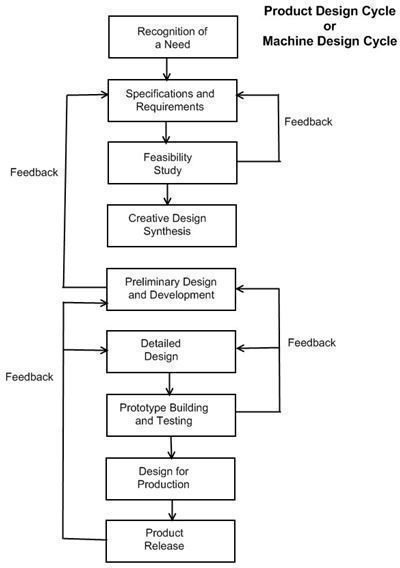The Product, System, Machine Design Engineering Cycle or Process: Design for Production and Product Release
Design for Production
Once the prototype testing is successful all the drawings, parts and material lists are sent to the production engineering department where the drawings are modified are so that the design for production is made for the completed project (see fig below). During the design for production stage the consideration is given to the design changes to so as to make it compatible with the most economical methods of production.
During design for production the manufacturing methods that will help manufacturing the product in most economic way and in the shortest possible time are considered. Every product requires multiple components and multiple phases of production. During the design for production the shortest possible manufacturing cycle for the product is found.
If certain components of the product requires machining, their production planning has to be done so as to identify which operation should be carried our first and how much time each of the machining operation will take. Say of instance if the shaft with multiple steps and threads is to be manufactured for the machine, the production manager will identify the raw material available for it. Then the shaft will have to be machined to certain diameter and length, and thereafter various steps will be made followed by threading and drilling. Most of these operations will be carried out on lathe machine in certain sequence within specified interval of time.
During the design for production phase due consideration is also given to the commercially available readymade parts in the market. In most of the cases the readymade parts are always cheaper than the in-house produced parts. Hence the design engineer may decide to manufacture those parts in-house that are not available in the market and purchase the readymade parts that are cheaply available.
In certain cases the there is possibility of replacing some materials with the equivalent satisfactory material at lower costs without affecting the performance or the life of the product. Finally, when all the production drawings are completed, they are sent to the production department for the product release.
Product Release
After making the complete drawings and production planning the drawings are sent the shop floor for product release and actual manufacturing of the product (see fig below). Even here the mass production is not done immediately; rather some prototypes are made and tested. If any drawbacks are found in the final these, these are sent back for the feedback to the preliminary or detailed design stage for making the necessary changes (see fig). Once the product is found satisfactory its mass production is carried out as per the production planning.
All the steps that have been described in the above system design or machine design cycle are in no way the complete detailed description of the product design nor is this the only path of designing. All the stages are just the guidelines for designing and manufacturing the cycle. Each individual company may have their own procedures and methodologies for designing the product.
System Design Cycle or Machine Design Cycle
Reference
Book: Machine Design by Dr. P. C. Sharma and D. K. Aggarwal
This post is part of the series: System Design Cycle or Machine Design Cycle
Whenever the new product or the machine is to be design there is a cycle of the steps that are followed. The sequence of the events in the machine design cycle or system design cycle have been codified Asimow, who is considered to be the father of system design or machine design. Here they are:
- System Design Cycle
- System Design Cycle: I) Recognition of a Need
- System Design Cycle: II) Specifications and Requirements
- System Design: III) Feasibility Study
- System Design Cycle: IV) Creative Design Synthesis
- System Design Cycle: V) Preliminary Design and Development
- System Design Cycle: VI) Detailed Design
- System Design Cycle: VII) Prototype Building and Testing
- System Design Cycle: VIII) Design for Production and IX) Product Release
